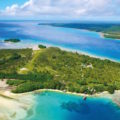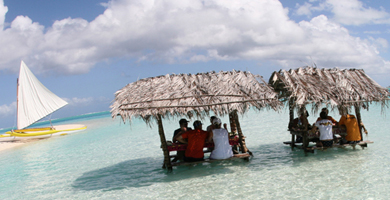MITIARO:Homestays in the Cook Islands
For adventurous travelers looking for traditional island culture, Mitiaro offers a unique local experience, as Pip Orr discovers.
Mitiaro is one of the Cook Islands most ruggedly beautiful, yet relatively unknown and remote islands of the South Pacific, previously only accessible to those who ventured off the beaten track. But for travelers keen to experience traditional island culture in an intimate setting, Mitiaro offers a unique travel experience for those dreaming of an authentic island escape away from all the tourist trappings. The Cook Island Tourist Corporation (CITC) recently launched a new, first-of-its-kind Homestay program, dubbed the Itiki experience, named after the eel for which Mitiaro is known. Sleeping in simple woven pandanus tree Kikau huts and listening to the waves breaking nearby, guests are hosted by local Mitiaro families and can experience first-hand the customary lifestyle and hospitality of the Mitiaroans who embrace visitors with warmth and kindness.
Once the twelve-seater lands on the sandy airstrip, visitors are greeted by the entire island (all 160 of them, including the children) at the rusty airport shed. The excitement from the locals is pleasantly overwhelming. Mitiaroan children rally to welcome any visiting kids and organize tours around the island on pushbike. As only one van exists on the island, owned by the local Missionary’s wife, Rangi, visitors pile in and are taken to their host and Kikau hut accommodation, which features one or two bedrooms, shower and toilet facilities and a relaxing porch area. Scooters are the only true mode of transport on the island and the majority of the “welcoming committee” escorts the visitors by trailing alongside the van to their destination. Inangaro “Vivienne” Taia hosts the Kovea Kikau hut homestay, nearest to the reef and coral beach, and produces a Nei (the Mitiaro version of a lei) upon arrival with a warm-hearted greeting and hugs all around, so that guests immediately feel part of the Mitiaroan family.
Mitiaro is only six kilometers wide—small compared to other islands—and the flattest of the Cooks. Flying in, the island appears deserted with only swamps, lakes, plantations and a craggy, rugged terrain of a raised coral reef called a makatea, which surrounds the island in view. As a result of a sunken volcano, which forms the swamps and lakes known as Te Rotonui (big lake) and Te Rotoiti (small lake), Mitiaro features some of the most beautiful of all the subterranean limestone caves and pools to be found in the Pacific.
Here, the islanders live in much the same way as their ancestors—farming, fishing and trading with nearby islands—so guests are able to experience the local culture and island living in much the same way. Days drift by leisurely, as guests eat fresh fruit and fish, swim, walk across the little beaches and coral reef, and explore the spectacular underground swimming holes.
If you are lucky, the local school will invite you to spend some time with them so the children can show off their skills with a quick introduction to their version of soccer.
Don’t miss exploring the island by scooter, which is enormous fun, but watch out for the roaming pigs and chickens as plenty live along the dirt roads and will cross in front of you. The alternative, bike riding, is a favorite past time for the local children and visitors can hire a bike and join them for a cross-country island adventure. The children also love to take visitors near the harbor to catch tuna with traditional iron tree rods and fishing lines. The Mitiaroan children beam with joy, and it’s uplifting to see how happy they are with their simple life. Head to the Tia’ara Beach on the western side of the island near the Kovea Kikau hut for spectacular swimming. The beaches are covered in beautiful white coral and the reef is ideal for walking and spotting fish and crabs. However, the most beautiful swimming can be found inland in deep underground swimming holes, some in the limestone caves. The best is Vai Nauri—a natural swimming pool with fresh water. The blue-green colors of the limestone dance on the water, which makes for a magical photo.
Historical sites like Mitiaro’s marae (ancient, open-air meeting grounds) reveal the islanders’ past prior to the Missionaries arriving. Visitors are required to take a guide from the Ariki tribe to visit these areas which are sacred territory and on private land. Mitiaro is also now part of a “green tourism” program. For $50, visitors are invited to plant a special native or fruit tree from the school nursery and all the proceeds go to the school, the women’s association and the agricultural association.
All homestay accommodations offer a delicious array of beautiful fresh food from the island including fruit and coconuts for breakfast, a lovely lunch and a hearty dinner with local fish, taro and kumara. Guests slumber peacefully in Kikau huts under mosquito nets as the island is quiet and tranquil—the only noise comes from the many little geckos eating the bugs and mosquitoes, or the sound of the local church bells and drums to wake the Mitiaroans for their Christian service at the crack of dawn. But these pleasant morning wake-up calls can also rouse you from sleep to watch the sunrise, a perfect start to another leisurely day on beautiful Mitiaro.
FACTS
 • Air New Zealand flies to Rarotonga directly from Sydney, Auckland and Los Angeles. (Currently on sale till Aug. 27th is an $806 return airfare special from LAX.) There are only three, 45-minute flights by Air Rarotonga per week to Mitiaro and cost approx. $450-500 return.
• Air New Zealand flies to Rarotonga directly from Sydney, Auckland and Los Angeles. (Currently on sale till Aug. 27th is an $806 return airfare special from LAX.) There are only three, 45-minute flights by Air Rarotonga per week to Mitiaro and cost approx. $450-500 return.
• There are three choices for the Mitiaro Homestay experience available through Cook Island Tours. The Kikau Hut Homestay is approx. $176 per night including meals. For further booking information contact: reservations@cookislandstours.co.ck
• For those wanting to explore the historical sacred sites on the island and have a guide for other activities, Julian Aupuni, Mitiaro’s Tourist Officer is available and Ronald Powell, the local working in the shop, offers his services to take people around the island.
• One little store exists on the island selling necessities, snacks and drinks, so bring what you need and plenty of cash as there is little offering at the bank to exchange money.
Visit Cook Islands Tourist Corporation for further details.
* Photos courtesy of Pip Orr and CITC.
Latest posts by Pip Orr
- MITIARO:Homestays in the Cook Islands - August 13, 2012













